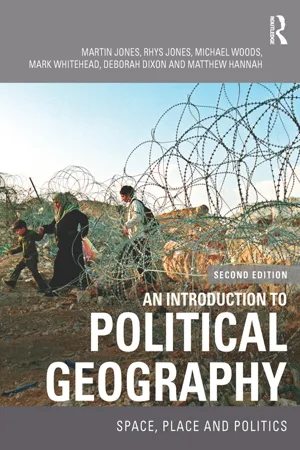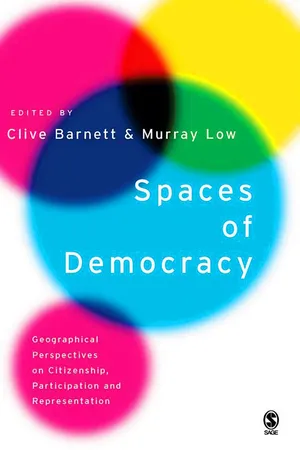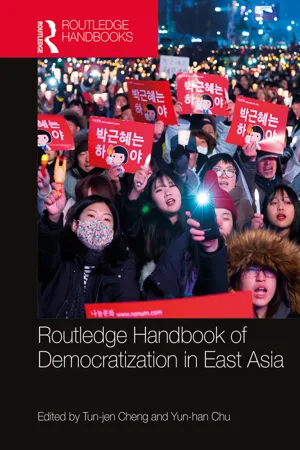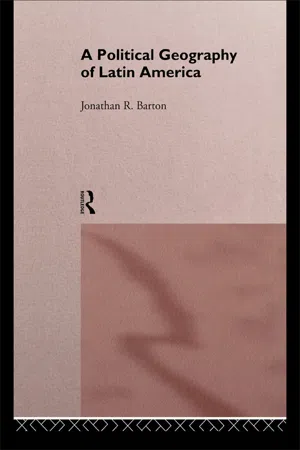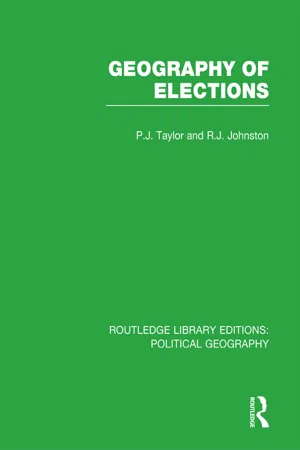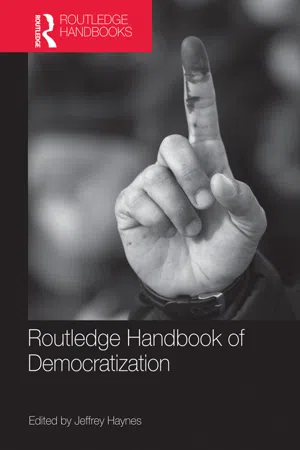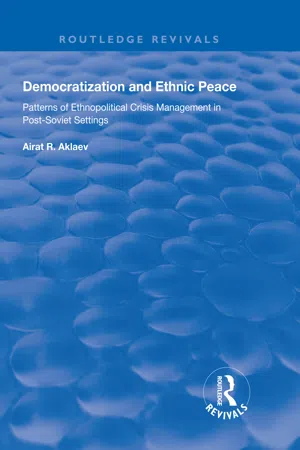Geography
Democratisation
Democratisation refers to the process of transitioning from an authoritarian or non-democratic political system to a democratic one. This process involves the establishment of democratic institutions, such as free and fair elections, an independent judiciary, and a free press. Democratisation can have significant impacts on a country's political, social, and economic development.
Written by Perlego with AI-assistance
Related key terms
8 Key excerpts on "Democratisation"
- eBook - ePub
An Introduction to Political Geography
Space, Place and Politics
- Martin Jones, Rhys Jones, Michael Woods, Mark Whitehead, Deborah Dixon, Matthew Hannah(Authors)
- 2014(Publication Date)
- Routledge(Publisher)
7Geographies of representation and mobilisationIntroductionThis chapter will focus on the way in which political formations shape and are energised by processes and possibilities of democracy. We will argue that democracy in all its forms is thoroughly geographical. This includes not only the outcomes of electoral democracy – where voting patterns are geographically differentiated, and where the territorial structure of electoral systems can change results – as discussed in the first half of the chapter, but also more participatory forms of democratic mobilisation – for example, through social movements – which the second half of the chapter will discuss.‘Democracy’ (the word was coined in Ancient Greece to denote the rule or power [kratia ] of the people [demos ]) refers in the broadest sense to any process in which many, most or all of the people affected by decisions are able to participate in making or influencing those decisions. Democracy can thus play a role in all spheres of social life, from the family to the workplace or economy to international relations. This chapter will focus primarily on political democracy, the sphere of public participation in or influence over the policies and decision-making processes of states. However, it is important to bear in mind that no strict boundary can be drawn between political democracy and cultural or economic democracy.Political democracy is now recognised by many people around the world as the chief source of the legitimacy of states, though the expansion of democratic institutions and practices among states has not been constant or geographically uniform (see Box 7.1 - eBook - ePub
Spaces of Democracy
Geographical Perspectives on Citizenship, Participation and Representation
- Clive Barnett, Murray Low, Clive Barnett, Murray Low(Authors)
- 2004(Publication Date)
- SAGE Publications Ltd(Publisher)
1Geography and Democracy: An Introduction
Clive Barnett and Murray Low
Where is Democracy?
Amid debates about globalization, neo-liberalism, and anti-capitalism, it is easy to forget that probably the most significant global trend of the last two decades has been the proliferation of political regimes that claim to be democracies. Democracy refers to the idea that political rule should, in some sense, be in the hands of ordinary people. It is also a set of processes and procedures for translating this idea into practices of institutionalized popular rule. In a remarkably short space of time, commitment to democracy has become near universal. The universalization of democracy as an ideal, if not as a set of agreed-upon practices, is historically unprecedented: ‘Nothing else in the world which had, as far as we can tell, quite such local, casual, and concrete origins enjoys the same untrammeled authority for ordinary human beings today, and does so virtually across the globe’ (Dunn, 1992: 239). This assertion pinpoints one key geographical dimension of the contemporary ascendancy of democratic norms. This is the problematic relationship between the particular historical-geography of democracy’s ‘origins’ on the one hand, and democracy’s more recent globalization on the other. However, it is striking how little impact processes of democratization, or democracy as a broader theme, have had on research agendas in human geography. While a great deal of critical analysis is implicitly motivated by democratic norms, there is relatively little empirical research or theoretical work that explicitly takes democracy to be central to the human geographic endeavour. This book aims to address this lacuna, by bringing together contributions from across the discipline of geography, addressing various research fields in which democracy is often a veiled backdrop, but not usually a topic of explicit reflection. We hope the book will thereby help to encourage the sort of detailed attention to issues of normative political theory that has recently been called for by others (Agnew, 2002: 164–78). - Tun-jen Cheng, Yun-han Chu(Authors)
- 2017(Publication Date)
- Routledge(Publisher)
Indeed, outside the schools focusing on domestic conditions such as economic development, institution, and culture, there is an existing literature addressing political development or democratic change in terms of international factors. This literature reveals that global or regional elements play a role, sometimes the most important role, in shaping national political landscape. Democracy is a product of interaction between domestic and international factors. If the international climate is favourable, democracies may survive in countries without favourable domestic conditions (Przeworski et al. 1996: 43).Geopolitics, international system, and democratization
In his 1991 book The Third Wave: Democratization in the Late Twentieth Century, Samuel Huntington outlined the geographic patterns of the expansion of democracy: first, North America and Western Europe; then Southern Europe, Latin America, and some in Asia; and most recently, Central and Eastern Europe. With these patterns, he revealed that the likelihood of a democratic transition and survival in a country may be related to factors outside the country, including general global environment and specific geopolitical attributes.Geopolitical thinkers from Mackinder (1904) and Fairgrieve (1921) to Skykman (1944) proposed the “heartland-inner crescent-outer crescent of sea powers”. According to them, the world political map can be divided into the Eurasian Heartland, mostly Russia and Central-Eastern Europe; the “Inner Crescent” surrounding the heartland, including Europe, Middle East, South Asia, and East Asia; then the “Outer Crescent” encircling the “Inner Crescent”, including the Americas, Africa, Australia, and the East Asian Island Arcs (Steinmetz 2012). International politics is competition and struggle between the Heartland and the Crescents. Basically the Eurasian rulers who command the Heartland always tend to expand and ultimately control the world; the powers in the Crescents must resist and contain the expansion.Central to geopolitics is great power politics related to geographic space. Empires are good examples. According to Riebe (2014: 1):- eBook - ePub
- Jonathan R. Barton(Author)
- 2002(Publication Date)
- Routledge(Publisher)
New perspectives must be able to reflect all the principal changes in 1990s society that Osvaldo Sunkel (1995, 45) terms, in the Latin American context, the ‘demand for democracy’, incorporating:While it could be argued that these spaces lie within national territorial spaces and therefore fall into the realm of the nation-state, the power-space relations established within them cannot be explained via an analysis of the state alone. The power-space relations that operate within households may have little connection with the organisation of the state and its control. Only by examining these ‘Other’ spaces and the power relations that are established within them can a fuller picture of power, space and their interactions be painted by political geographers. Power sharing is resisted by the close associations of economic élites and political élites. It is not until the social structures of Latin American societies are transformed beyond their present confines and hierarchies that democracy and democratic transitions can be established as a normal state of political affairs on the continent. Ali Abootalebi (1995), in a discussion of Democratisation in the South during the 1980s, writes that as long as the state remains the ultimate centre of power, prospects for democracy will remain weak.the increasing generalized aspirations and demands for greater participation in the economic realm (ownership, incomes, consumption, jobs); in the social arena (human rights, social mobility, grass-roots organizations); in political activity and power (elections, citizenship, participation in decisionmaking); and in cultural life (access to education, information, the media, and cultural goods and services generally). These demands have spread and become particularly strong among former relatively excluded sectors such as women, youth, religious minorities, regional groups, and ethnic minorities and majorities.Political geography should extend beyond the state in that it should be inclusive of all people, not only ‘recognised’ citizens such as registered voters. It is with this in mind that an understanding of the role of the informal sector, or those groupings operating beyond the state, should be facilitated, engendering a geopolitics of inclusion, of democratic political geography, rather than a generally exclusionary geopolitics of the nation-state. The informal sector operating outside recognised formal public and private sector operations, within which as much as two-thirds of Latin America’s economically active population may be engaged, provides an area of investigation that political geographers must also confront. The qualification of informal sector participants as ‘forgotten’ by the state, or rather those who direct or usurp its functions, should not thus render them forgotten by the political geographer. - No longer available |Learn more
- Meredith Marsh, Peter S. Alagona(Authors)
- 2023(Publication Date)
- Barrons Educational Services(Publisher)
democratization. Democracy can take many forms. Government structures in the United States, for example, differ in many ways from the diversity of forms present in Europe, Latin America, Asia, and elsewhere. Many people believe, however, that some form of democratic representation is a fundamental human right and is essential for promoting social welfare, economic development, and security. In recent decades, democracy has spread to new areas as autocratic regimes have given way to more transparent, popularly elected governments. Yet the transition to democracy has proven extremely turbulent in some areas, and weak or superficial forms of democracy have emerged in other areas. In many parts of the world, people still live in countries where they lack the ability to choose their leaders or to participate meaningfully in political processes.Spatial Conflict
It should be quite evident by now that a large component of political geography involves the investigation of historical and current conflicts over territory at all scales, all across the globe. Whether it be the designation of waters to specific countries, the effects of imposed boundaries on many of the colonized countries throughout the developing world, or tensions in choosing voting districts within the United States, space ownership has proven one of the most volatile issues throughout human history. Spatial conflict occurs at all geographic scales. Currently in Los Angeles, the San Fernando Valley is seeking secession from the city. The citizens of the valley think that Los Angeles does an inadequate job supplying their civic needs, and that if given authority to spend their own tax money, they would do a better job providing for their citizens. On a different scale, in 2002 Spain and Morocco disputed ownership of a tiny island off the coast of Morocco called Perejil (and Leila in Morocco). Both countries worked to establish an agreement without using military force. Finally, on a global scale, in recent decades debate and regulation over environmental problems that cross national boundaries have moved to the top of the agenda in international policy discussions. Issues such as ozone depletion, biodiversity loss, and climate change will eventually affect all people, but certain advanced countries quite often contribute more to these global problems, making universal legislation difficult to unilaterally enforce. - eBook - ePub
- Peter J. Taylor, Ron Johnston(Authors)
- 2014(Publication Date)
- Routledge(Publisher)
Part Five Towards a Geography of PowerPassage contains an image 9 Geography, Elections, Representation and Power
Our focus in this book has been on the geography of elections, and we have highlighted three particular aspects of that geography; (1) the spatial variations in voting for different candidates, parties and issues which reflect the spatial division of labour and the process of politicization; (2) the locational variables which are related to information flows and influence how voters react to various political issues; and (3) the effect of the division of a territory into constituencies on the translation of votes into seats, and hence on the pattern of representation. Within such a framework, we have considered the election as an event in its own right, worthy of study for its own sake. But the purpose of an election is to allocate political power (as compared with a referendum or plebiscite, which is conducted to obtain a decision on a particular issue). If there are important geographical influences on voting and representation, then these should be followed by similar influences on the allocation of power, and so it is to this topic that we address our final chapter. In doing so, our interest moves away from the interaction between voters and political actors and focuses instead on the roles and performances of the successful actors in the election process. As Cox (1976) has pointed out in a recent review, such a concern with the outputs of the electoral process is unusual among geographers, but it is crucial if the value of geographical study of the whole political system is to be demonstrated.The concept of power is a crucial one to much analysis in social science, and its definition has been the focus of much debate. Our concern here is with a relatively narrow view of power, which is that level of control over political decision-making which is allocated to different elected representatives. This is in line with the general positivist tone of the whole book; we accept the current electoral systems as given and analyse their inputs and outputs rather than focus on their position in the wider socioeconomic system (Miliband, 1969). Our aim is simply to illustrate the political implications of electoral systems. - eBook - ePub
- Jeffrey Haynes(Author)
- 2012(Publication Date)
- Routledge(Publisher)
Why not us? Everyone knew from his or her neighbour’s experience that transition to democracy was a possibility. Not only in Eastern Europe, but also in parts of Africa and Asia, a diffusion or demonstration effect seemed operative. These processes of diffusion and demonstration encouraged elites and civil society groups to press for change towards democracy. Hence, democratization occurred not only in temporal, but also in spatial clusters. Countries seem to affect each other: living in a democratic region makes it more likely that a regime will democratize.Indeed, since the third-wave transitions took place, many theorists sought to include the influence of democratic clustering in their research (Huntington 1991 ; Lipset 1994 ; Pridham and Vanhanen 1994 ). Linz and Stepan, for example, emphasized this influence during democratization processes, positing that ‘the more tightly coupled a group of countries are, the more a successful transition in any country in the group will tend to transform the range of perceived political alternatives for the rest of the group’. Indeed, they continued, ‘international diffusion effects can change political expectations, crowd behaviour, and relations of power within the regime almost overnight’ (Linz and Stepan 1996 : 76). Lipset (1994 : 16) concluded that a ‘diffusion, a contagion, or demonstration effect seems operative, as many have noted, one that encourages democracies to press for change and authoritarian rulers to give in’.Based on these theoretical ideas, cross-national empirical studies show indeed that there is a clear clustering of democratization around the world. In his quantitative large-N study on the impact of economic crises on democracy, Gasiorowski (1995 ) also paid attention to the possible ‘demonstration effects’ of democratic neighbours (see also Starr 1991 - eBook - ePub
Democratization and Ethnic Peace
Patterns of Ethnopolitical Crisis Management in Post-Soviet Settings
- Airat R. Aklaev(Author)
- 2019(Publication Date)
- Routledge(Publisher)
ancien regimes from which transitions have recently departed - bureaucratic authoritarian, state socialist, post- totalitarian, sultanistic - are very different from the oligarchic regimes of the late XlXth and early XXth centuries. The actors and strategies involved are therefore quite different. Furthermore, the practical unfeasibility, in the current context, of gradually extending the right to vote to broader sectors of the population forecloses the path of incremental democratization through elite contestation, known as essential characteristics of the West European transitions. Finally, the democratization process itself can create or exacerbate other problems with which new democracies must then grapple. In this regard, analysts mention the problems of communal conflict, foreign war, and social decay (Huntington, 1996, p. 8-10).Recent Conceptualizations of Democratization
Recent literature views the relationship between democracy and democratization as both process-oriented and action-oriented. O’Donnell and Schmitter (1986, p. 9-10) analyze it on the basis of processual unfolding of democracy’s guiding principle of citizenship.Democratization ... refers to the process whereby the rules and the procedures of citizenship are either applied to political institutions previously governed by other principles (e.g., coercive control, social tradition, expert judgment, or administrative practice), or expanded to include persons not previously enjoying such rights and obligations ( e.g., nontaxpayers, illiterates, women, youth, ethnic minorities, foreign residents), or extended to cover issues and institutions not previously subject to citizen participation (e.g., state agencies, military establishments, partisan organizations, interest associations, productive enterprises, educational institutions, etc.).Scholars draw a crucial distinction between liberalization and democratization, the two types of political changes that frequently occurred in the Second and Third Worlds. Whereas the former encompasses the more modest goal of merely loosening restrictions and expanding individual and group rights within an authoritarian regime, the latter goes beyond expanded civil and political rights. As a movement towardestablishing a popular political regime, democratization involves holding free elections on a regular basis and determining who governs on the basis of these results. Liberalization, on the contrary, is understood as the partial opening of an authoritarian system short of choosing governmental leaders through freely competitive elections (e.g. O’Donnell and Schmitter, 1986, p. 11; Mainwaring, 1992, p. 245). Though liberalization and democratization are closely related, the two may not occur simultaneously during a transition. Liberalization without alterations in the structure of authority has occasionally been given the euphemistic label of ‘tutelary democracy’ or ‘liberalized authoritarianism’ (dictablanda
Index pages curate the most relevant extracts from our library of academic textbooks. They’ve been created using an in-house natural language model (NLM), each adding context and meaning to key research topics.
